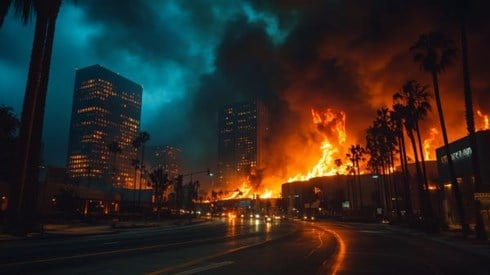California Wildfires Drive Record $80 Billion Insured Losses in Early 2025

August 07, 2025

Global insured losses from natural catastrophes reached $80 billion in the first half of 2025, nearly doubling the 10-year average, according to preliminary estimates from Swiss Re Institute. The losses mark the second costliest first half-year on record, with US wildfires and severe thunderstorms driving the bulk of the total.
The wildfires that tore through Los Angeles County in January caused $40 billion in insured losses—the highest ever recorded for a wildfire event. Fueled by prolonged Santa Ana winds and drought, the fires destroyed more than 16,000 structures in areas with high concentrations of high-value single-family homes. Swiss Re attributed the unprecedented loss to growing exposure in fire-prone zones, particularly California's wildland-urban interface, where exposure growth has outpaced other regions by a factor of 1.9 since 1990.
Wildfire-related insured losses have surged in the last decade. Before 2015, they accounted for just 1 percent of natural catastrophe claims; today, they represent 7 percent. In fact, 8 of the 10 costliest wildfire events have occurred within the past 10 years.
Severe thunderstorms added $31 billion to insured losses in the first half, falling below Swiss Re Institute's trend estimate of $35 billion and lower than record-setting years 2023 and 2024. Nonetheless, thunderstorms remain a major and volatile risk driver. Urban expansion into hazard-prone regions, along with inflation and rising asset values, has heightened the financial impact of these events.
"The strongest lever to increase the resilience and safety of communities is to double down on mitigation and adaptation," Jérôme Haegeli, Swiss Re's group chief economist, said. "Our research shows that, for example, flood protection measures such as dykes, dams, and floodgates are up to 10 times more cost-effective than rebuilding."
Swiss Re also reported that a 7.7-magnitude earthquake in Myanmar in March resulted in insured losses of $1.5 billion in Thailand. Meanwhile, heat waves and flash flooding began affecting parts of Europe and Texas in early summer, signaling potentially volatile months ahead.
With the North Atlantic hurricane season underway, forecasts predict three to five major hurricanes—above the long-term average. Swiss Re emphasized that storm impact depends largely on landfall locations and warned that up to 60 percent of annual insured losses typically occur in the second half of the year.
"Reinsurers not only act as a shock absorber for peak risks. They also have a crucial role to help the world prepare and respond to the growing natural catastrophe risk by understanding, quantifying, and transferring the risk," Balz Grollimund, Swiss Re's head of catastrophe perils, said.
Economic losses from natural catastrophes totaled $135 billion in the first half of 2025, with overall economic losses reaching $143 billion. Insured losses from man-made disasters remained flat at $7 billion. Should current trends persist, Swiss Re said total insured losses for 2025 could exceed its full-year projection of $150 billion.
August 07, 2025
